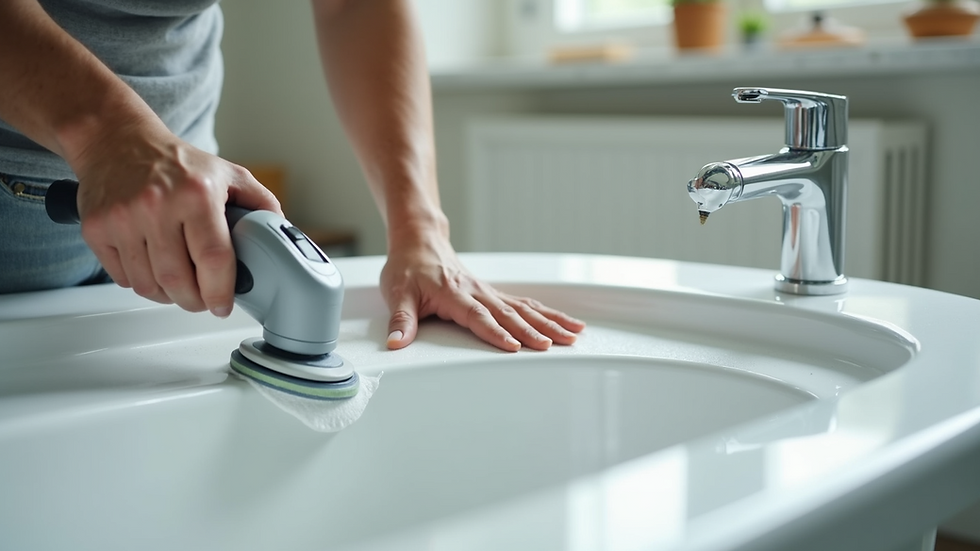Best Practices for Restoring Acrylic Bathtubs
- Luis Tovar
- 11 minutes ago
- 3 min read
Acrylic bathtubs are popular for their lightweight design, durability, and smooth finish. However, over time, they can develop scratches, stains, and dullness that detract from their appearance. Restoring an acrylic bathtub can bring back its original shine and extend its lifespan without the need for costly replacement. This guide covers the best practices for bathtub restoration, focusing on acrylic tubs, to help you achieve professional-looking results.
Understanding Bathtub Restoration for Acrylic Surfaces
Bathtub restoration involves cleaning, repairing, and refinishing the surface to improve its look and functionality. For acrylic bathtubs, the process requires special care because acrylic is a softer material compared to porcelain or cast iron. Using harsh chemicals or abrasive tools can cause permanent damage.
Key steps in acrylic bathtub restoration include:
Thorough cleaning: Removing soap scum, mildew, and mineral deposits.
Surface repair: Fixing chips, cracks, and scratches with appropriate fillers.
Sanding and smoothing: Preparing the surface for refinishing.
Applying a new finish: Using specialized coatings to restore gloss and protect the tub.
Proper restoration not only enhances the bathtub’s appearance but also prevents further damage and makes cleaning easier.

Essential Tips for Effective Bathtub Restoration
To restore an acrylic bathtub successfully, follow these practical tips:
Use gentle cleaning agents: Avoid abrasive cleaners. Instead, use mild detergents or specialized acrylic tub cleaners.
Repair minor damages promptly: Small chips and scratches can be filled with acrylic repair kits available at hardware stores.
Sand carefully: Use fine-grit sandpaper (around 400-600 grit) to smooth the surface without scratching it deeply.
Work in a well-ventilated area: Refinishing products often contain strong chemicals, so ensure good airflow.
Follow manufacturer instructions: Whether using repair kits or refinishing sprays, adhering to guidelines ensures the best results.
Test products on a small area first: This helps avoid unexpected reactions or discoloration.
By following these steps, you can maintain the bathtub’s integrity and achieve a smooth, glossy finish.

Can acrylic be reglazed?
Yes, acrylic bathtubs can be reglazed, which is a popular method for restoring their appearance without replacement. Reglazing involves applying a new coating over the existing surface to cover imperfections and renew the finish.
Benefits of reglazing acrylic bathtubs include:
Cost-effectiveness compared to buying a new tub.
Quick turnaround time, often completed within a day.
Environmentally friendly by reducing waste.
Restores the tub’s shine and smoothness.
Adds a protective layer that resists stains and scratches.
Professional reglazing services use specialized materials designed for acrylic surfaces, ensuring durability and a natural look. If you prefer a DIY approach, there are reglazing kits available, but professional results are usually more reliable.

How to Maintain Your Restored Acrylic Bathtub
After restoration, maintaining your acrylic bathtub is crucial to prolong its beauty and functionality. Here are some maintenance tips:
Clean regularly: Use non-abrasive cleaners and a soft cloth or sponge.
Avoid harsh chemicals: Steer clear of bleach, ammonia, or abrasive powders.
Prevent scratches: Avoid using metal scrubbers or sharp objects in the tub.
Dry after use: Wipe down the tub to prevent water spots and mineral buildup.
Address stains quickly: Use baking soda paste or vinegar solutions for mild stains.
Use bath mats: Place a non-slip mat to protect the surface from heavy impact.
Routine care will keep your acrylic bathtub looking fresh and reduce the need for frequent restorations.
When to Consider Professional Acrylic Bathtub Refinishing
While DIY restoration can be effective for minor issues, professional acrylic bathtub refinishing is recommended for extensive damage or when you want a flawless finish. Professionals have access to high-quality materials and equipment that ensure:
Long-lasting results.
Uniform coating without bubbles or streaks.
Proper surface preparation and curing.
Warranty or satisfaction guarantees.
If your bathtub has deep cracks, large chips, or persistent stains, contacting a professional service like acrylic bathtub refinishing can save time and provide peace of mind.
Enhancing Your Bathroom with a Restored Acrylic Bathtub
Restoring your acrylic bathtub not only improves its appearance but also enhances the overall look of your bathroom. A shiny, smooth tub can make the space feel cleaner and more inviting. Consider pairing your restored tub with updated fixtures, fresh caulking, and complementary décor to create a cohesive and stylish bathroom environment.
Regular restoration and maintenance can extend the life of your acrylic bathtub by many years, making it a smart investment for your home.
By following these best practices for bathtub restoration, you can keep your acrylic bathtub looking beautiful and functional for years to come. Whether you choose to tackle minor repairs yourself or hire a professional for refinishing, proper care is key to preserving this essential bathroom fixture.




Comments